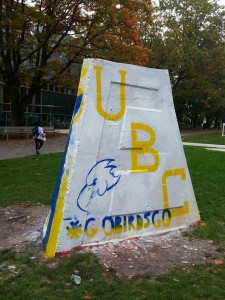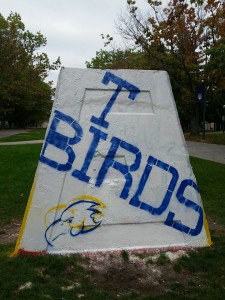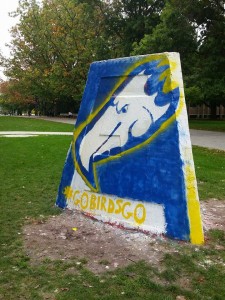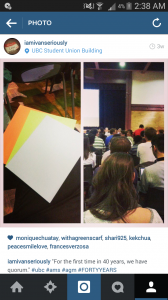Growing up in a Jewish household has been one of the defining aspects of my identity. This is not a religious statement, rather it is a cultural and familial one. While Judaism is a strong, ancient religion genetically and ethnically tying together a group of people across disparate parts of the world through a well established belief system, this is not the aspect of my identity I am focusing on with regard to Judaism. Dorothy Smith talks of everyday world experiences, such as walking your dog and avoiding walking on manicured property areas, as defining how people co-ordinate their world and make sense of it through the constraints of institutions. Taking this a step further, if institutions are understood as the rules by which people live in society, than religions can be understood as the different sets of culturally specific rules through which families come together in identity construction- that is- during times of transition requiring a common set of social definitions of what it means to be family.
To demonstrate this from my own childhood with an example, every Saturday (or Sabbath, known as the holy day of rest according to Jewish tradition) my family would walk together to the Synagogue for spiritual services (or Shul as it is often referred to). Time at Shul is probably not all that different from what you’d experience at a Church on a Sunday. It is generally a source of community-building, but on top of that, reflection on the past week through scripture, a reminder of the religious hierarchy that must prevail in the institutions, as well as the commonly permissive ways we celebrate all events within a community throughout the life course, such as births, deaths, coming of age events, and the like. I attribute my dual identity in a similar vein as DuBois’ concept of double consciousness to my personal atheistic beliefs in combination with my strong ties to my family as well as my Jewish cultural identity. Further adding to this sense of double consciousness are strong historical and cultural memories that tie my Jewish “blood” to my identity, most notably the Holocaust and the ways in which Jews have for many centuries stood up to varying forms and degrees of antisemitism and persecution.
DuBois defines Double Consciousness through a different identity lenses. For him, it is through problematizing of his African-American identity that he arrives at the concept. This is because during the time that he was writing, still under the oppression of Jim Crowe laws in the United States and having a mixed black and white background, he felt he could “pass” for either identity in many contexts, but it was difficult for him to achieve comfort in his own way because he always felt one “half” of himself in flux in many situations. DuBois was one of the very first non white people to pass through the education system in the United States at the time, and it is no wonder he felt a strong sense of internal strife during this period of change in the American conception of race and oppression at this period.
Relating this back to my own experience as a Jewish student at UBC, I attended an event at the Hillel House several weeks ago. Hillel is a centre for Jewish life on campus. I have been to some of their events before, especially in my first and second years of schooling at UBC because it was one of the first areas of campus I decided to look into because of my identity. The first few years of my time at UBC were a marked period of transition for me, however, as I was in the midst of forming strong opinions about my identity, such as my atheist views, feminist identification, coming out as gay to my family and friends, and more politically leftist leaning lenses of the world after being exposed to more of the world than I had ever been before. These changes, or developments in my identity for that matter have had a profoundly conflicting and tension-inducing effect on my relations with my Jewish “half”. I hadn’t been back to Hillel House for probably 2 to 3 years when I decided to attend this event several weeks ago because I needed the space, time, and energy to reflect on my relationship with my Jewish identity.
I haven’t solved these tensions by any stretch, however I have been able to gain some perspective. One such insight, for example, is that somehow in political and academic attitudes and discussions about the Israeli-Palestinian conflict is that it is somehow the case that if you support one side (Israel) you must necessarily be a politically right-leaning oriented individual, and on the other hand if you support the other side (Palestine), you must necessarily be a politically left-leaning oriented individual. There is very little space to exist on the political and cultural spectrum outside of this binary. This is exemplified by a relatively recent, sad moment in Canadian political history when the then-president of the Green Party of Canada was essentially forced to resign over a letter he wrote in support of a nuanced view toward the Israeli-Palestinian conflict this summer, amid continued warfare between the two sides. This demonstrated a refusal on the part of the party to consider allowing the party position to not take a specific position on the issue in support of one side or the other. This was a heavy moment for me, as a generally progressive politically inclined individual, believing that the Green Party is rightly making strides in the right direction toward environmental sustainability and responsibility in Canada. It meant that politically, if you are progressive (or left-oriented) and are not against supporting Israel, there’s no representation for you in Canada, and in most other democracies in the world for that matter.
This article is not about Israel, because my views on Israel are extremely complex and personal for that matter. However, in relation to identity construction, I am attempting to draw a parallel between my dual identity as a Jewish student at UBC in the 2010s and Du Bois’ concept of double consciousness. This is a product of attending many events, such as the one at Hillel I attended a few weeks ago, where my relative support for Israel (not Israel’s policies) has been perceived as support for exclusionary-based, ideologically right-wing or Islamophobic attitudes. In the opposite direction, my feminist and anti-oppressive attitudes have also been perceived as those that are necessary for a view toward Israel that is nothing less than a branding of the Jewish state as a menace, a demonic, colonizing, patriarchal force that must be boycotted, removed, and sanctioned in the international community.
Sadly, such attitudes on both sides of the situation seem to be polarizing, especially when facing the strong, anonymously protected opinions of the citizens of the internet. Not only are those attitudes riddled with hate speech at times toward the side they are “against”, they also overwhelmingly show misunderstanding toward a host of other cultures, ideological political attitudes (such as feminism, Islam, and Judaism for examples), and people. Never has a time been so appropriate from my perspectives to take Dorothy Smith’s words to heart, that the everyday must be where we start, based on what we see on the ground. So much has been distorted by the media and by culturally hegemonic scripts. Safe spaces for people of varying perspectives (but which in reality, most of the time, are much closer in ideological space than apart) to discuss their dual identities, as is so much more common now than in the past, are a necessity for achieving tomorrow’s peace and unifying our deepest internal tensions and identities.
*Citations: W.E.B. Du Bois (1903/2012) From “The Souls of Black Folk.” In Scott Appelrouth and Laura Desfor Edles. Classical and Contemporary Sociological Theory (2nd edition). Thousand Oaks, CA: SAGE Pine Forge Press. Pp. 271-283.
Smith, Dorothy (1987/2012). From “The Everyday World As Problematic.” In Scott Appelrouth and Laura Desfor Edles. Classical and Contemporary Sociological Theory (2nd Edition). Thousand Oaks, CA: SAGE Pine Forge Press Pp. 570-3.



